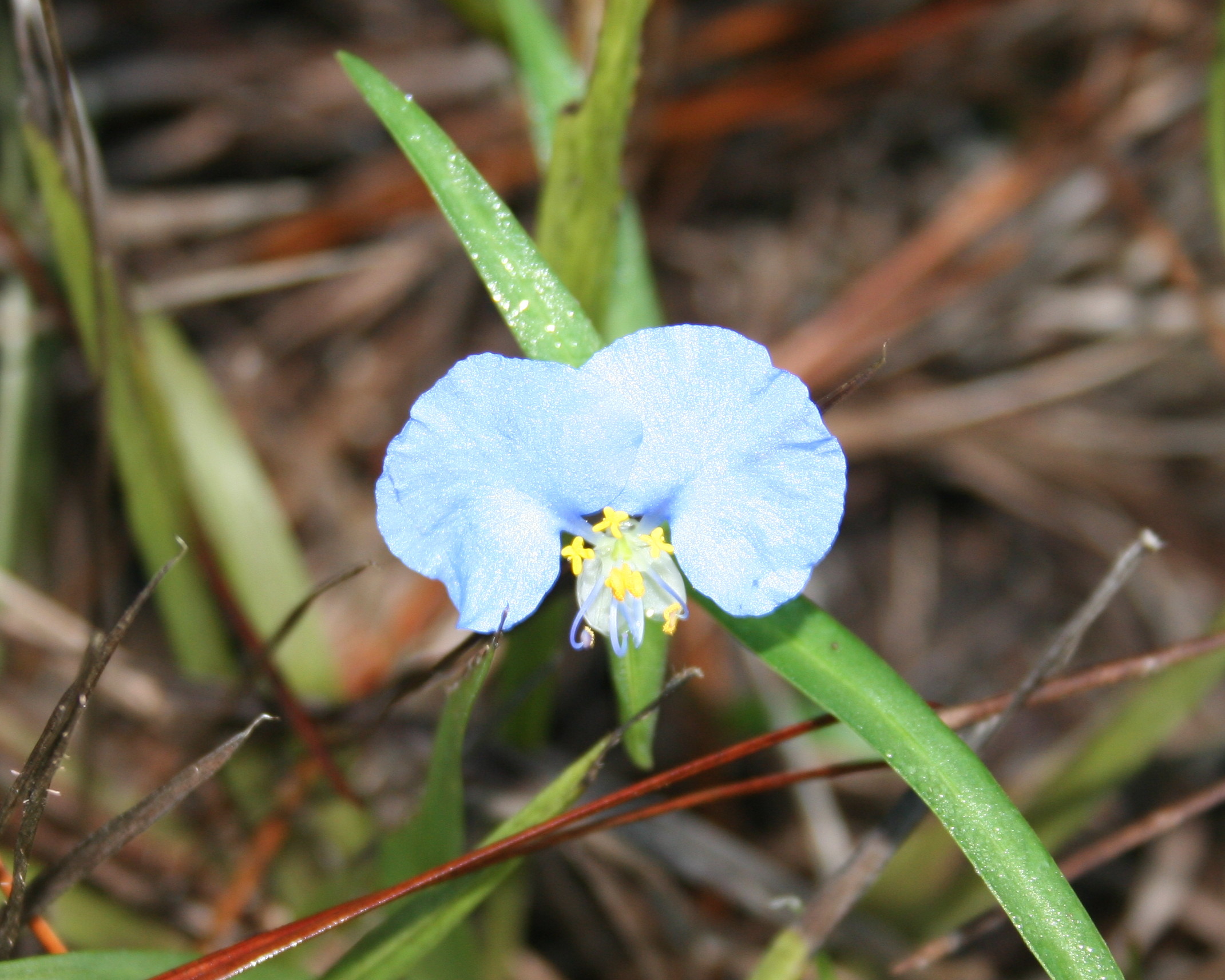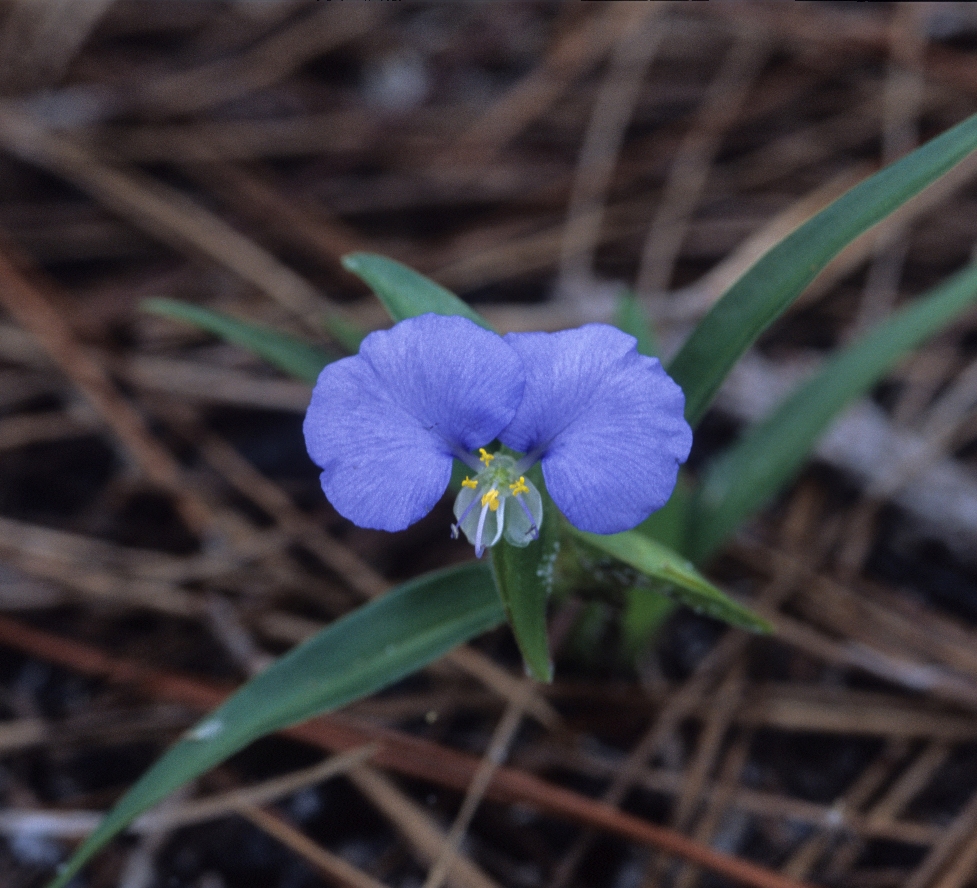Difference between revisions of "Commelina erecta"
(→Taxonomic notes) |
|||
| Line 22: | Line 22: | ||
Synonyms: ''Commelina angustifolia'' Michaux; ''C. crispa'' Wooton; ''C. elegans'' Kunth [http://efloras.org/florataxon.aspx?flora_id=1&taxon_id=222000043 The Flora of North America]. | Synonyms: ''Commelina angustifolia'' Michaux; ''C. crispa'' Wooton; ''C. elegans'' Kunth [http://efloras.org/florataxon.aspx?flora_id=1&taxon_id=222000043 The Flora of North America]. | ||
| − | Varieties: ''C. erecta'' Linnaeus var. ''angustifolia'' (Michaux) Fernald | + | Varieties: ''C. erecta'' Linnaeus var. ''angustifolia'' (Michaux) Fernald; ''C. erecta'' Linnaeus var. ''erecta'' |
==Description== <!-- Basic life history facts such as annual/perrenial, monoecious/dioecious, root morphology, seed type, etc. --> | ==Description== <!-- Basic life history facts such as annual/perrenial, monoecious/dioecious, root morphology, seed type, etc. --> | ||
Revision as of 13:45, 15 April 2019
| Commelina erecta | |
|---|---|

| |
| Photo by Tom Miller, Apalachicola National Forest, FL | |
| Scientific classification | |
| Kingdom: | Plantae |
| Division: | Magnoliophyta - Flowering plants |
| Class: | Liliopsida – Monocotyledons |
| Order: | Commelinales |
| Family: | Commelinaceae |
| Genus: | Commelina |
| Species: | C. erecta |
| Binomial name | |
| Commelina erecta L. | |

| |
| Natural range of Commelina erecta from USDA NRCS Plants Database. | |
Common name: Whitemouth Dayflower; Erect Dayflower; Sand Dayflower
Contents
Taxonomic notes
Synonyms: Commelina angustifolia Michaux; C. crispa Wooton; C. elegans Kunth The Flora of North America.
Varieties: C. erecta Linnaeus var. angustifolia (Michaux) Fernald; C. erecta Linnaeus var. erecta
Description
A description of Commelina erecta is provided in The Flora of North America. In Collier County, FL, an albino form was observed.[1]
Distribution
Ecology
Phenology
C. erecta has been observed flowering from May to September and also in November with peak inflorescence in June and July.[2] In repeated annual censuses conducted in October in permanently marked plots in native longleaf pine-wiregrass communities in southern Georgia, C. erecta appeared only in certain years, seemingly in particularly wet years, and was fairly common in the years that it appeared.[3]
Seed dispersal
This species is thought to be dispersed by gravity. [4]
Pollination
In Daytona Beach, FL, the pollen-feeding bee fly (Poecilognathus punctipennis) was observed visiting C. erecta[5] and performing their unique foraging behavior.[6] The following Hymenoptera families and species were observed visiting flowers of Commelina erecta at Archbold Biological Station:[7]
Halictidae: Augochlorella aurata, Augochloropsis metallica, A. sumptuosa, Lasioglossum nymphalis, L. placidensis
Megachilidae: Megachile brevis pseudobrevis
Conservation and management
Cultivation and restoration
Photo Gallery
References and notes
- ↑ Observation by Roger Hammer in CREW Marsh, Collier County, FL, May 23, 2017, posted to Florida Flora and Ecosystematics Facebook Group May 23, 2017.
- ↑ Nelson, G. PanFlora: Plant data for the eastern United States with emphasis on the Southeastern Coastal Plains, Florida, and the Florida Panhandle. www.gilnelson.com/PanFlora/ Accessed: 7 DEC 2016
- ↑ Robertson, K.M. 2017 Pebble Hill Fire Plots database. Tall Timbers Research, Inc., Tallahassee, Florida.
- ↑ Kirkman, L. Katherine. Unpublished database of seed dispersal mode of plants found in Coastal Plain longleaf pine-grasslands of the Jones Ecological Research Center, Georgia.
- ↑ Observation by Peter May in Tiger Bay State Forest, Daytona Beach, FL, May 23, 2017, posted to Florida Flora and Ecosystematics Facebook Group May 23, 2017.
- ↑ Deyrup MA (1988) Pollen-feeding in Poecilognathus punctipennis (Diptera: Bombyliidae). The Florida Entomologist 71(4):597-605.
- ↑ Deyrup, M.A. and N.D. 2015. Database of observations of Hymenoptera visitations to flowers of plants on Archbold Biological Station, Florida, USA.
